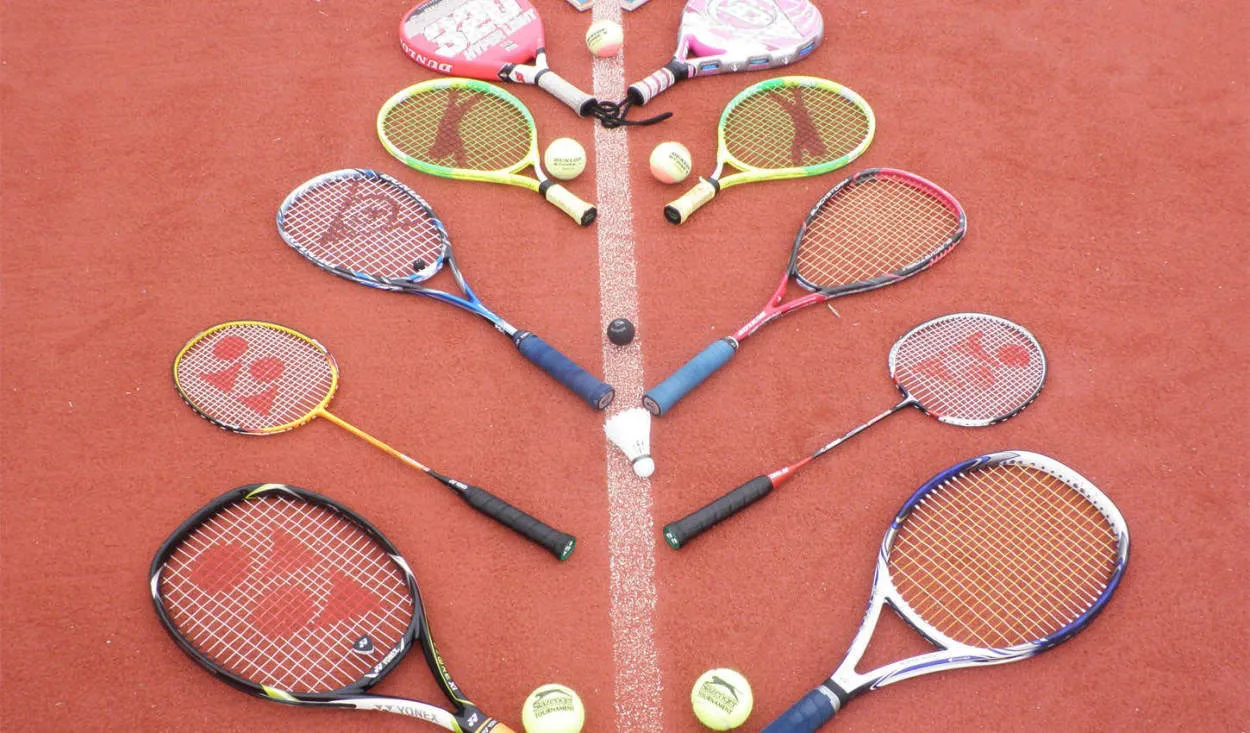Are you passionate about racquet sports and looking to upgrade your equipment? Look no further! In this ultimate guide, we will delve into all the essential equipment needed for racquet sports, including tennis, badminton, squash, and racquetball. Whether you’re a seasoned player or just starting out, this guide will help you make informed decisions to enhance your game.
Selecting the Right Racquet for Your Sport
Choosing the perfect racquet can significantly enhance your performance in racquet sports. Whether you’re into tennis, badminton, squash, or any other racquet sport, finding the right racquet is crucial. Here are some key factors to consider:
1. Sport-Specific Racquets
Each racquet sport has its own unique requirements. Tennis racquets differ from badminton or squash racquets in terms of weight, size, and string tension. Make sure to choose a racquet that is specifically designed for your sport of choice.
2. Racquet Weight
The weight of the racquet plays a significant role in your game. Lighter racquets offer better maneuverability, while heavier ones provide more power and stability. Consider your playing style and physical strength when selecting the weight of your racquet.
3. Grip Size
A proper grip size ensures comfort and control during gameplay. Too small or too large of a grip can lead to discomfort or even tennis elbow. Visit a sports store and try different grip sizes to find the one that feels most comfortable in your hand.
4. String Tension
The tension of the racquet strings affects the amount of power and control you have over the ball. Higher tension provides more control, while lower tension offers more power. Experiment with different string tensions to find the one that suits your playing style.
5. Budget
Consider your budget when selecting a racquet. While expensive racquets may offer advanced features, there are also excellent options available at more affordable prices. Find a balance between quality and budget that works for you.
Remember that selecting the right racquet is a personal decision. Take the time to try out different models, consult with more experienced players, and consider your own preferences to make an informed choice. A well-suited racquet can greatly enhance your enjoyment and performance in your chosen racquet sport.
Differences Between Tennis
Tennis is a popular racquet sport that can be played both recreationally and competitively. There are several key differences between different types of tennis, including:
1. Surface
Tennis can be played on various surfaces, such as clay, grass, or hard courts. Each surface affects the ball’s bounce and speed differently, requiring players to adapt their strategies and playing style accordingly.
2. Scoring System
The scoring system in tennis differs from other racquet sports. Instead of using points or sets, tennis uses a unique system where players accumulate points within games, sets, and matches. The basic scoring structure includes Love (0), 15, 30, 40, and game.
3. Equipment
Tennis requires specific equipment, including a tennis racket and tennis balls. The choice of racket and balls may vary depending on the player’s level of play and personal preference.
4. Doubles vs. Singles
Tennis can be played in singles (one player against another) or doubles (two players against another pair). Each format has its own dynamics and strategies, with doubles requiring teamwork and communication.
5. Court Size
The size of tennis courts can vary depending on whether it is a singles or doubles match. Singles matches are played within the singles court, which is narrower, while doubles matches utilize the wider doubles court.
Squash
Squash is a popular racquet sport played by millions of people around the world. It is a fast-paced game that requires agility, speed, and strategy. In squash, players use a small rubber ball and racquets to hit the ball against the walls of a four-walled court.
One of the main benefits of playing squash is its excellent cardiovascular workout. The constant movement and quick changes in direction help to improve stamina and burn calories. Squash also helps to improve hand-eye coordination and reflexes, as players must react quickly to hit the ball.
When it comes to squash equipment, there are a few essential items that every player needs. The most important piece of equipment is the squash racquet. It is important to choose a racquet that suits your playing style and skill level. Beginners may prefer a racquet with a larger head size for increased power and forgiveness, while advanced players may opt for a racquet with a smaller head size for better control.
Another important piece of equipment is the squash ball. Squash balls come in different speeds ranging from slow to fast. Beginners generally start with a slower ball as it allows for longer rallies and easier ball control. As players progress, they can switch to faster balls for a more challenging game.
Other equipment that can enhance the playing experience includes squash shoes with good traction to prevent slipping on the court, protective eyewear to prevent eye injuries from the fast-moving ball, and a wristband or sweatband to absorb sweat during intense rallies.
To get started with squash, it is recommended to join a local club or find a squash court in your area. Many clubs offer lessons and leagues for players of all skill levels. It is also important to warm up and stretch before playing to prevent injuries and improve performance.
In conclusion, squash is an exciting racquet sport that provides a great physical workout while also improving coordination and reflexes. With the right equipment and practice, anyone can enjoy the game and experience the thrill of playing squash.
The Ultimate Guide to Racquet Sports Equipment [and Badminton Equipment]
Racquet sports, including badminton, require specific equipment to ensure an enjoyable and successful game. Here is a comprehensive guide to the essential badminton equipment that every player needs:
1. Badminton Racquet
The most crucial piece of equipment in badminton is the racquet. Look for racquets made of lightweight materials such as graphite or carbon fiber, which offer better control and maneuverability. Choose a racquet that suits your playing style and grip preference.
2. Shuttlecocks
Shuttlecocks, also known as birdies, are the projectiles used in badminton. There are two types: feathered shuttlecocks, made with real feathers, and plastic shuttlecocks. Feathered shuttlecocks offer better flight and control but are more expensive and delicate. Plastic shuttlecocks are more durable and suitable for recreational play.
3. Badminton Shoes
Proper footwear is essential in badminton to prevent injuries and provide better grip on the court. Look for shoes with non-marking soles and optimal cushioning for shock absorption. Badminton shoes have specific features that enhance lateral movements and quick directional changes.
4. Badminton Clothing
Wear comfortable and breathable clothing that allows for easy movement on the court. Opt for lightweight materials that wick away sweat to keep you cool and dry during intense gameplay. Badminton-specific apparel often includes features like mesh ventilation and ergonomic designs.
5. Grip Tape
Applying grip tape to your racquet handle enhances your grip and prevents slipping. It provides better control and feel, especially during intense rallies. There are various grip thicknesses and materials available, allowing you to choose the one that suits your preferences.
6. Accessories
Other accessories such as wristbands, headbands, and ankle braces can provide additional support and protection during gameplay. These optional accessories help absorb sweat, prevent injuries, and enhance your overall comfort on the court.
In conclusion, having the right badminton equipment is essential for improving your gameplay and preventing injuries. Invest in quality equipment that suits your playing style and level of expertise. Remember to maintain and replace your equipment regularly to ensure optimal performance and safety during your badminton matches.
The Evolution of Racquet Technology
Racquet sports have been enjoyed by people around the world for centuries. Over time, the technology behind racquets has evolved significantly, enhancing performance and transforming the way these sports are played.
Wooden Racquets
In the early days, racquets were crafted from wood. These wooden racquets had a simple, traditional design and were relatively heavy. While they provided decent control, they lacked power and had a limited sweet spot.
Introduction of Metal Frames
The 1960s marked a significant shift in racquet technology with the introduction of metal frames. Aluminum and steel racquets became popular due to their durability and lightweight design. Players now had more power and better maneuverability with these racquets.
Graphite Composites
In the 1980s, graphite composites revolutionized racquet technology. These racquets were made with graphite and other advanced materials, resulting in lighter frames and increased power. Players could generate more speed and spin, improving their overall game.
Advanced Design Features
As technology continued to advance, racquet manufacturers started implementing various design features. These included larger sweet spots, improved shock absorption systems, and specialized string patterns to enhance control and feel.
Integration of Nanotechnology
In recent years, nanotechnology has been incorporated into racquet manufacturing. Nano-sized particles are strategically placed within the racquet frame, providing enhanced stability, strength, and control. This innovation has further pushed the boundaries of racquet performance.
The Future of Racquet Technology
The evolution of racquet technology shows no signs of slowing down. With ongoing research and development, we can expect even more advancements in the future. From smart racquets with built-in sensors to innovative materials, the possibilities are endless.
Maintenance Tips for Racquet Sports Gear
Racquet sports, such as tennis, badminton, and squash, require specialized equipment to ensure optimal performance on the court. Proper maintenance of your racquet, shoes, and other gear is essential to prolong their lifespan and enhance your overall playing experience. Here are some maintenance tips to keep your racquet sports gear in top condition:
1. Racquet Care
To keep your racquet in good shape:
- Regularly inspect the strings for wear and tear. Replace them if they become loose or show signs of fraying.
- Protect your racquet from extreme temperatures and direct sunlight, as they can warp the frame.
- Keep the grip clean and dry. Replace it if it becomes worn or slippery.
2. Shoe Maintenance
Proper care of your racquet sports shoes is crucial for both performance and hygiene:
- Clean your shoes after each game or practice session. Use a soft brush to remove dirt and debris.
- Avoid using harsh chemicals on the shoes as they can damage the materials. Instead, opt for mild soap and water.
- Allow your shoes to air dry completely before storing them.
3. Bag Organization
Your gear bag plays a vital role in protecting your equipment. Follow these tips to keep it organized:
- Separate wet and dry items to prevent moisture damage.
- Use compartments or pouches to keep small accessories like grips, sweatbands, or spare strings easily accessible.
- Regularly clean your bag to remove any dirt or odors.
4. General Maintenance
Don’t forget these additional tips:
- Inspect your gear regularly for any signs of wear and tear.
- Store your equipment in a cool, dry place to prevent damage from humidity.
- Follow manufacturer’s instructions on proper usage and maintenance for specific products.
Balancing Cost and Quality in Racquet Selection
When it comes to choosing the right racquet for your favorite racquet sport, finding the balance between cost and quality is essential. Whether you play tennis, badminton, squash, or any other racquet sport, understanding how to make a wise investment in your equipment is crucial for your performance on the court.
Know your playing style
Before delving into the cost and quality considerations, it’s important to assess your playing style. Are you a power player who relies on strong shots, or do you favor precision and control? Different racquets cater to various playing styles, so understanding your strengths and weaknesses will help guide your decision-making process.
Consider your skill level
Beginner or recreational players might lean towards more affordable options as they explore the sport and develop their skills. On the other hand, intermediate and advanced players who have a higher level of proficiency may benefit from investing in racquets with better quality and features, as these can significantly enhance their performance and capabilities on the court.
Balance cost and quality
While it’s tempting to go for the most expensive racquet on the market, it’s important to remember that cost doesn’t always equate to quality. Assess the construction materials, technology, and brand reputation to determine the value a racquet offers. Consider your budget and find a racquet that falls within your price range while still meeting your desired quality standards.
Try before you buy
Before committing to a racquet, take advantage of demo programs or borrow racquets from friends or local clubs to try them out. Each racquet has a unique feel, and what works well for one player may not suit another. Testing different racquets will allow you to determine which one aligns best with your playing style and provides the desired quality without blowing your budget.
Seek expert advice
If you’re still unsure about which racquet to choose, consult with a knowledgeable salesperson, coach, or experienced player. They can provide valuable insights and recommendations based on your playing style, skill level, and budget. Their expertise can steer you in the right direction and help you make an informed decision.
Conclusion
In conclusion, finding the right balance between cost and quality is crucial when selecting a racquet. Assessing your playing style, skill level, and budget will guide your decision-making process. Remember to try out different racquets and seek expert advice if needed. By doing so, you can ensure that your chosen racquet enhances your performance while staying within your budget.
Conclusion
In conclusion, the ultimate guide to racquet sports equipment highlights the importance of selecting the right gear for optimal performance. Whether it’s tennis, badminton, squash, or any other racquet sport, investing in the appropriate racquet, strings, grip, and other accessories can greatly enhance your game. Furthermore, considering factors such as skill level, playing style, and budget are crucial when making these equipment choices. By following this guide, players can make informed decisions to improve their overall performance on the court.




